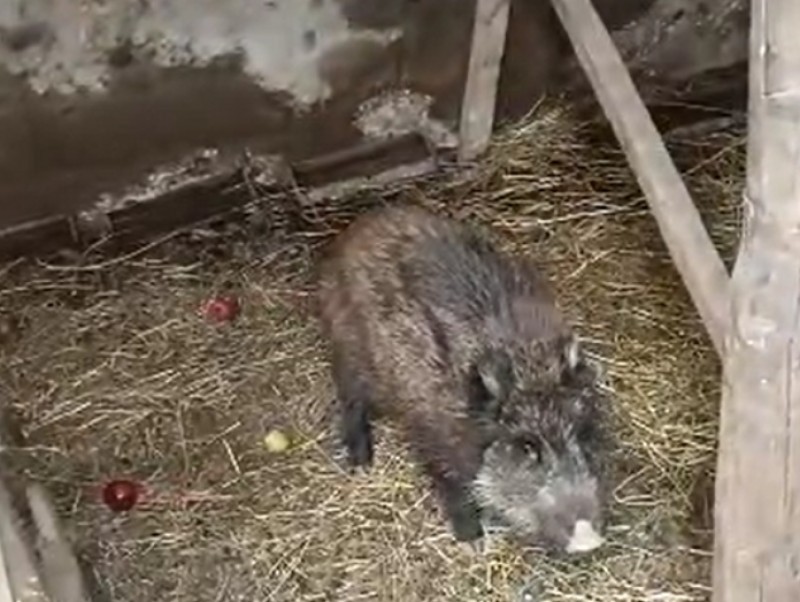
Wild boars have been last seen in the Chon-Jargylchak reserve 30 years ago. Talantbek Usupov, the head of the local public association "Ala-Too Bugu," tells that during the Soviet era, one poacher could shoot 10-15 animals a day. "Whether it's a legend or true, it's hard to say now. But we set ourselves the goal of bringing back wild boars to the reserve," - Talantbek began the amazing story of the return of wild animals to their natural habitat.
"Ala-Too Bugu" united residents of the Jeti-Oguz district of the Issyk-Kul region to assist the government in protecting the Chon-Jargylchak zoological reserve, established by the decision of the Council of Ministers of the Kyrgyz SSR in 1990. The reserve received the status of a "protected natural area" due to the presence of "Red Book" species - Tian Shan brown bear, snow leopard, maral, and large predatory birds. In "Chon-Jargylchak," it was planned to preserve "hunting-commercial" animals and birds and restore their population. But due to the collapse of the Union, work on forestry and flora and fauna inventory never started. In recent years, the reserve has been transferred to the management of the General Directorate of the Issyk-Kul Biosphere Territory, which, due to limited resources, could only allocate "one staff unit" for the permanent protection of the over 23 thousand hectares of the reserve zone.
The reserve became a fully protected natural area in 2021 when activists from the "Ala-Too Bugu" NGO took it under their wing in cooperation with the Issyk-Kul Biosphere Territory Directorate. Their functions included protecting animals and plants from poachers, monitoring compliance with the reserve regime, and educational work. The non-governmental organization "СAMР Alatoo" provided public gamekeepers with equipment, technical means (video surveillance systems, camera traps, binoculars, telescopes, communication tools), and organized training on legal issues regulating responsibility for poaching, tree felling, and other illegal actions in the reserve.
"The local population plays a significant role in preserving biodiversity in the reserve. Natural objects are often the main source of income for people. In this case, restrictions and bans on hunting, logging, fruit picking, mushroom and herb collection cause various conflicts. One way to solve the problem is to involve local residents in natural resource management and planning activities in the reserve. And our foundation, СAMР Alatoo, applies the natural resource management approach jointly with the communities," - said Murat Zhumashev, the head of the organization.
The idea to bring back boars to "Chon Jargylchak" arose among residents of Issyk-Kul during an exchange of experience with "colleagues" from the almost identical public association "Shumkar Tor" from the Kemin district. The plan included catching animals in the Chon-Kemin national park and transporting them to "Chon Jargylchak" in specially made wooden crates. But first, they had to get permission from the Ministry of Ecology of the Kyrgyz Republic and the National Academy of Sciences for the relocation of boars.
"While we were preparing the documents and setting up traps in the Chon-Kemin park to catch boars, winter came, and the animals went deep into the forest. Therefore, we decided to postpone the "operation" until spring. And after patrolling the reserve territory, unexpectedly for ourselves, we saw traces and characteristic burrows of boars. A few days later, a local resident reported that she saw three wild boar piglets at the end of the village. One of our association members found one of the piglets in her barn," - Talantbek Usupov said.
By the tracks and burrows, gamekeepers determined that there are at least 30 adult individuals and piglets currently living in the reserve. The camera trap has so far recorded only two wild boars and two piglets. "Ala-Too Bugu" is confident that the animals came from neighboring Barskoon, Tamga, Kichi-Jargylchak, Ak-Terek to escape poaching.
"Thanks to our conservation efforts in the reserve, a "quiet" zone has formed here, where animals are not threatened. Therefore, boars have returned," - confidently explains the director of "Ala-Too Bugu."
Scientists have found that creating a favorable and safe environment, as well as instincts and behavior, can lead wild animals back to their former habitats. These factors have also contributed to the return of animals in other countries in the region. For example, active work was carried out in Kazakhstan to restore the population of kulans, and the number of rare species of mountain goats has increased in Tajikistan.
The activists from "Ala-Too Bugu" plan to observe wild boars and account for them, and, importantly, to explain to local residents the benefits of "new old" neighbors. According to Talantbek Usupov, they have already had to find compromises and respond to complaints from villagers that boars are digging burrows, and some even threatened to start shooting animals. "People do not know that an increase in boars will lead to wolves, lynxes, and other predators not attacking livestock, and the dug-up soil is beneficial for the natural regeneration of forests." Lately, poachers have almost stopped hunting in "Chon-Jargylchak": they are afraid of getting caught on camera traps. Although they find ways to bypass control and simply steal the installed video surveillance system.
With the return of wild boars, gamekeepers pin their hopes on the future of natural resources and biodiversity in "Chon-Jargylchak." This story is an example of joint work of local communities, NGOs, and government structures to achieve a common goal - the long-term preservation of wildlife.
Итоги пастбищного сезона 2018 года были подведены на очередном заседании районной пастбищной комиссии (РПК).
MoreThe development of the unified method, "Monitoring Pastures at the Local Level," is nearing completion.
MoreЧетыре новых моста построены в 2018 году в Кыргызстане при поддержке ОФ “CAMP Алатоо” и Швейцарской ассоциации “Памирские...
More